
How To Hoop Lens

If you've been around here a minute you've probably seen many of these on/off charts from Hoop Lens:
On one level these are relatively straightforward: what happens when a guy is on the court versus what happens when he's off the court. But there are a lot of moving parts with these things. More than once I've headed over to Hoop Lens seeking to confirm a hypothesis and gotten confounded. Also sometimes the toplines can mislead.
This post is an attempt to clarify what is and isn't important in these things, and how we try to use them.
Rubric 1: Beware massive three point swings
Eli Brooks's on/off is some kind of education in this department.
Big Ten games + Toledo
I think we can safely assert that if Michigan played a billion possessions with Brooks on the floor and a billion with him off the floor, opponents would not be shooting 14 points(!) better from deep when Brooks is playing. Similarly, losing a 37% three-point shooter—and mostly replacing him with Chaundee Brown, a 40% three-point shooter—shouldn't result in a 14 point(!) drop in 3FG%.
Three point shooting is swingy for whole teams over the course of a whole season, and 3P% defense is even swingier. Via Kenpom:
Pomeroy says "there’s just very little predictive value in a team’s early 3-point defense numbers," and when we look at subsets like Brooks's above we're looking at about 4 games of data—not even the 9 in the graph above.
That three point shooting anomaly makes the topline look like Michigan's defense is basically the same whether Brooks is on the floor or not. But if you look at literally any drill-down other than three-point shooting you'll see it's advantage Brooks. Michigan forces almost 50% more TOs, allows fewer offensive rebounds, puts guys on the line far less often, and has slightly better two-point D. They also force more of those very bad twos when Brooks is on the court. We're looking at a guy who should be on the All-Defense team who happens to be on the receiving end of some bad luck from behind the line.
[After THE JUMP: more rubrics!]
That's not to say that there's never any data in those lines. I just want to see that 3FGA/FGA rate move in tandem. I think Austin Davis's on/offs do demonstrate a weakness in his game:
all games because slashing out cupcakes takes out too many Davis possessions
Opponents shoot better from 3 when he's on the court, and they get a ton more threes. Those two lines together are Donta Scott and Micah Potter getting clean pick and pop looks.
I do think that there may be some reality to the Michigan 3P% drop when Brooks isn't on the court because he's a senior who knows what he's doing on the court and helps the offense flow into good shots even if he's not being credited with assists as he does so. To confirm or disconfirm you'd have to actually chart a bunch of shots and see their relative quality. The data here isn't dense enough to make a call.
Rubric 2: Beware Kenpom time effects
This one doesn't come up a ton because usually you're not blasting the whole conference into smithereens but there's a notable effect for some players this year because some of their time is spent with the motley crew of walk-ons and deep bench players who get crushed in Kenpom time. This is mostly Terrance Williams, who looks like a disaster factory if you just take a simple on/off:
Drop out possessions he shares with Adrien Nunez—who has only gotten on the floor as part of the Kenpom kids and IIRC has not missed any of those possession—and things look less alarming:
(This is a spot where the 3FG% on offense is somewhat real since Williams is 0/9. He is part of that denominator.)
This also tends to make the starters all look like the straw that stirs the drink. 38 of the 244 possessions without Brooks have been the Kenpom kids, which doesn't sound like a ton but has a big impact on the bottom line because that lineup is giving up 1.18 PPP and allowing 61.1 shooting from two. Drop those out and Michigan's non-Brooks D PPP goes from 0.9 to 0.85.
All the starters have a 3-5 point swing in two point D in their favor, and ~all of that is because the "off court" section is getting distorted by Kenpom time.
Rubric 3: Two-point shooting is the most reliable thing available
Two-point shots are a plurality of things that occur in a basketball game. They have the most sample size of any of the drill-down stats except maybe turnover rate. Also, two point shooting conflates two different things: 1) where those shots are coming from and 2) whether they go down. A guy who contests well at the rim will see his two point D on/offs prosper. A guy who doesn't get back cut and stays in front of his guy and forces midrange twos will also prosper.
One of the items I'm most confident asserting from these splits is judging a center's defense. Here's Giorgi Bezhanishvili versus Kofi Cockburn:
A seven-point gap in two-point D is big, and both sides of this equation have a lot of possessions. Also when I flip it—Giorgi on, Cockburn off—those numbers stay the same. (Sometimes you get confounding variables like Kenpom time or both guys playing together that mean the relationship is not symmetrical.) You can usually get a clean split between two centers and that data is likely to mean something.
Rubric 4: TO rate gaps are also notable
Brooks's numbers above offer some insight into why Juwan Howard loves him and Michigan's gotten clunked the last two times Brooks has missed a game (Minnesota this year, Wisconsin last year). Despite being the lowest-usage guy on the team, Eli Brooks's primary skill—knowing where to be and what to do at all times—really pops off the chart. Otherwise a metronomic ability to get into sets and limit clean looks for the opponent is almost unnoticeable if you're not a coach.
You can see similar effects across the league. Sasha Stefanovic is a low-usage Just A Shooter but since he's getting replaced by freshmen whenever he's not on the court the banana peels multiply:
There is also a stark effect at Iowa. Ace caught this in his latest Big Ten Reset: CJ Fredrick is kind of important for them.
Fredrick returned after missing most of the last five games and Iowa had 10 turnovers in a 10-point win over Rutgers in their best performance since he got hurt.
No matter the usage, a guy who holds down his teams TOs is a tentpole for that team, and losing them is going to hurt.
Miscellaneous Rubrics
Bullets:
- OREB differences are more important than DREB differences but OREBs are so individualistic that I don't think these charts tell you much more than a plain old OREB rate.
- FTA/FGA is largely in the same boat. Last year Michigan's FTA rate went up 10 points when Zavier Simpson, a very hackable PG who created a ton of shots for his teammates, was on the bench. There are maybe some contexts in which I'd single it out as an interesting piece but I don't know that I've run across one yet.
- FT% is mostly useful to highlight the fact that things are out of your control sometimes.
- I try to check different combinations of players on and off sometimes, as it can be hard to tell who's driving a particular bus. There is no particular player driving Michigan's defense, except maybe Brooks. The huge 2P% D gap Mike Smith has is evidence enough that you have to be careful with these things.
- 3FGA/FGA is an important indicator. Fredrick above has a ten point gap, which is partly about Fredrick and partly about the fact that Iowa's backup guards are not shooters.
February 11th, 2021 at 1:20 PM ^
If this is done with the top 8 Michigan players, what player has the largest descrepency between off with/without and defense with/without. I would have guessed Franz or Smith. But Brooks has quite the difference between both.
February 11th, 2021 at 1:34 PM ^
Williams numbers are bad because Nunez gets tunnel vision and is trying to throw up a shot at all cost, rather than playing the game.
February 11th, 2021 at 1:44 PM ^
Interesting that you single out Adrian when he has only taken 7 shots the entire season. Which is 19.5% of his teams shots taken when on the floor. Lower than last year. On the other hand Jaron Faulds has taken 27% of shots when on the floor and he's only made 1. not coincidentally, the Kenpom team has fared a little better since Faulds was replaced for Baird in that lineup.
Zeb Jackson is probably the primary chucker in that group though. So I'd put Nunez pretty low on the Kenpom time offenders.
February 11th, 2021 at 4:17 PM ^
As KT mentioned I don’t think that is true about Nuñez this year. (Previous years absolutely.)
I have noticed him for actually playing coherent defense, getting a rebound, and generally “leading” the KP-time group. Still not sure he is a B1G caliber rotation player unless he starts hitting 40%+ from 3 but really think JH and staff have done a great job rounding him out as a player.
February 11th, 2021 at 2:10 PM ^
Are there pricing details available for Hoop Lens? Seems like a lot of fun to play around with but the site is pretty bare bones and didn't see what a membership costs
February 11th, 2021 at 2:22 PM ^
And Hoop Lens doesn't even know about Eli's thunderdunks!
February 11th, 2021 at 2:57 PM ^
The other factors that are the wild card in this are:
- the quality of players the opponents are putting on the floor. Is it 1s vs 1s or 1s vs 1s/2s or 1s vs 2s. Or as in the case of Williams 2s/3s vs. 1s/2s. Brooks plays against the best.
- the length of time the player is on the floor which affects the proportion of time against the combinations above
February 11th, 2021 at 5:25 PM ^
There's an "adjusted plus-minus" metric that adjusts for all nine other players on the court. The NBA uses it pretty extensively and they can get reasonable robust results because they have a lot more possessions. Tougher in college to get a decent metric and I'm not aware of anyone that publishes it for college.
February 11th, 2021 at 5:00 PM ^
It's not so much that Brooks is a victim of bad luck while he's on the floor. 37% for opponents isn't very unlucky and 0.89 points per possession allowed is outstanding.
It's just that the team has been very lucky on opponent threes while he's not on the floor. If that makes him personally unlucky because he doesn't look as good in relative terms, ok I guess, but his team is the best in the conference while he's on the floor and he checks the oppositions best guard which should be enough to get him on the all defense team (it won't but it should).
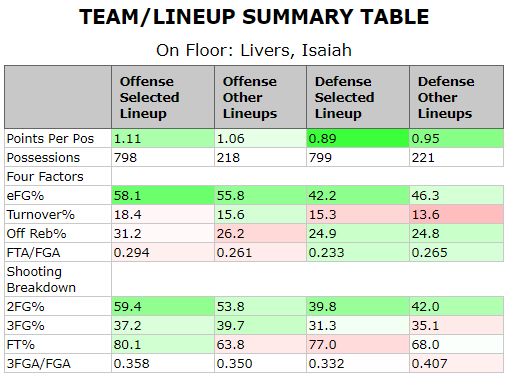
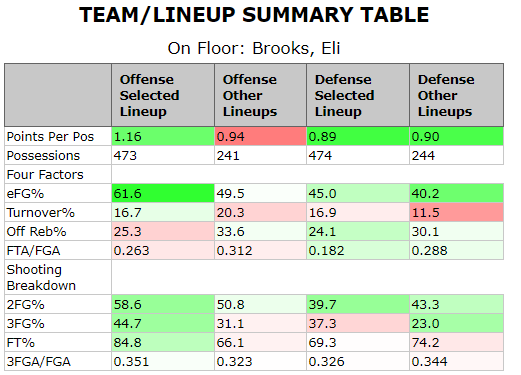
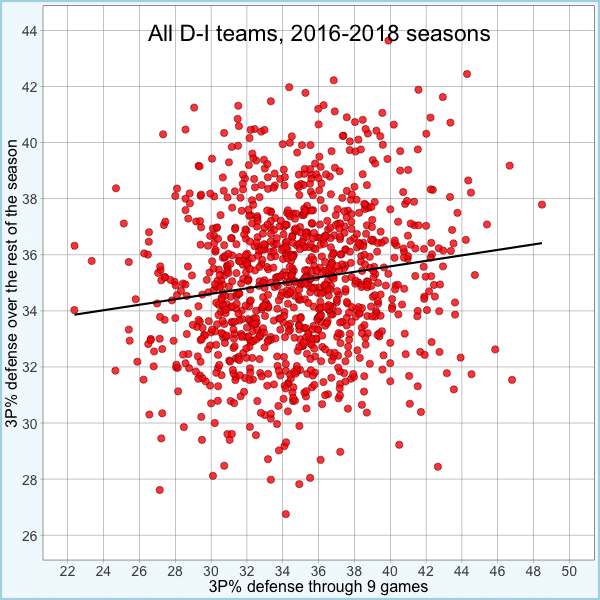
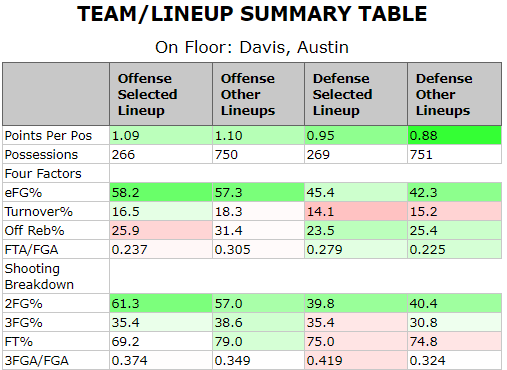
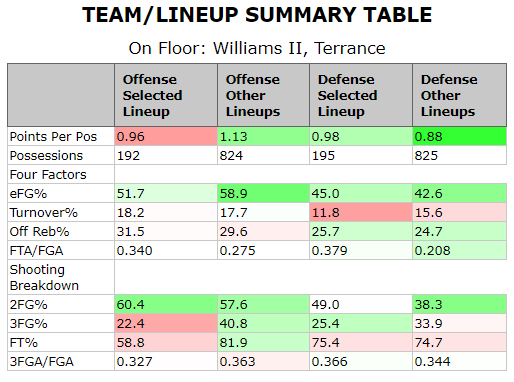
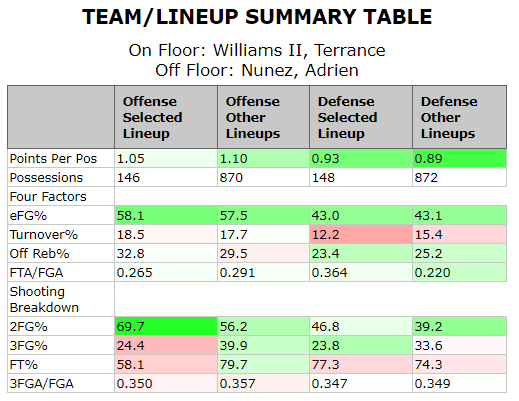
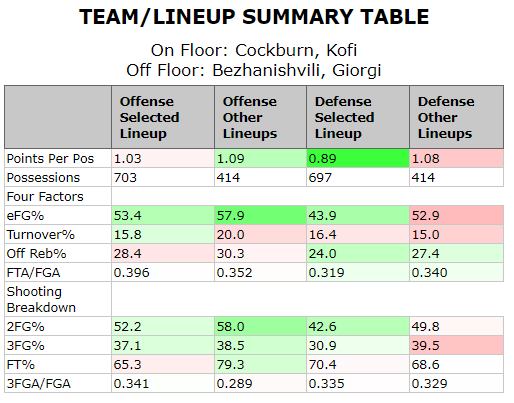
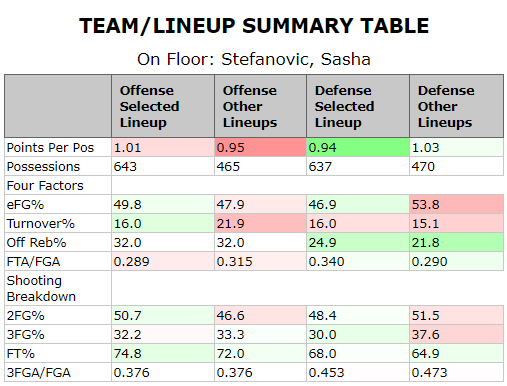
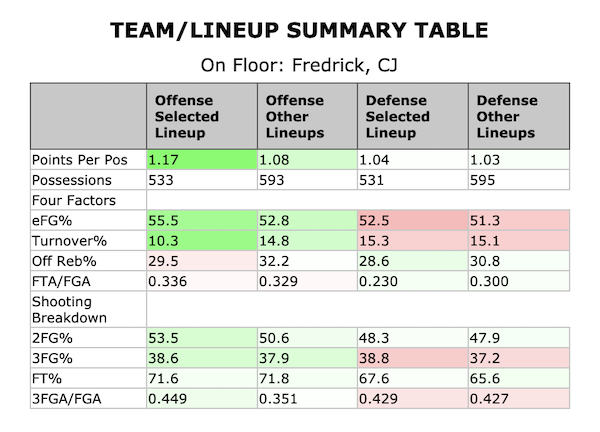
Comments